Large Methane Emission from the River Inlet Region of Eutrophic Lake: A Case Study of Lake Taihu
Abstract
:1. Introduction
2. Materials and Methods
2.1. Study Area and Sampling Locations
2.2. Lake CH4 Survey
2.3. Auxiliary Data
3. Results
3.1. Environmental Condition
3.2. Spatial Variations of CH4 Emission
3.3. Temporal Variations of CH4 Emission
3.4. Factors Influencing the CH4 Emission Variability
4. Discussion
4.1. Potential Factors Sustaining the Large CH4 Emission in River Inlet Region
4.2. Role of Temperature in CH4 Flux Variability
4.3. Implication of the Study
5. Conclusions
Author Contributions
Funding
Institutional Review Board Statement
Informed Consent Statement
Data Availability Statement
Conflicts of Interest
References
- Nisbet, E.G.; Dlugokencky, E.J.; Bousquet, P. Methane on the Rise-Again. Science 2014, 343, 493–495. [Google Scholar] [CrossRef] [PubMed] [Green Version]
- Kirschke, S.; Bousquet, P.; Ciais, P.; Saunois, M.; Canadell, J.G.; Dlugokencky, E.J.; Bergamaschi, P.; Bergmann, D.; Blake, D.R.; Bruhwiler, L.; et al. Three Decades of Global Methane Sources and Sinks. Nat. Geosci. 2013, 6, 813–823. [Google Scholar] [CrossRef] [Green Version]
- Stavert, A.R.; Saunois, M.; Canadell, J.G.; Poulter, B.; Jackson, R.B.; Regnier, P.; Lauerwald, R.; Raymond, P.A.; Allen, G.H.; Patra, P.K.; et al. Regional Trends and Drivers of the Global Methane Budget. Glob. Chang. Biol. 2021, 28, 182–200. [Google Scholar] [CrossRef] [PubMed]
- Borges, A.V.; Deirmendjian, L.; Bouillon, S.; Okello, W.; Lambert, T.; Roland, F.A.E.; Razanamahandry, V.F.; Voarintsoa, N.R.G.; Darchambeau, F.; Kimirei, I.A. Greenhouse Gas Emissions from African Lakes Are No Longer a Blind Spot. Sci. Adv. 2022, 8, eabi8716. [Google Scholar] [CrossRef]
- Rosentreter, J.A.; Borges, A.V.; Deemer, B.R.; Holgerson, M.A.; Liu, S.; Song, C.; Melack, J.; Raymond, P.A.; Duarte, C.M.; Allen, G.H.; et al. Half of Global Methane Emissions Come from Highly Variable Aquatic Ecosystem Sources. Nat. Geosci. 2021, 14, 225–230. [Google Scholar] [CrossRef]
- Bastviken, D.; Tranvik, L.J.; Downing, J.A.; Crill, P.M.; Enrich-Prast, A. Freshwater Methane Emissions Offset the Continental Carbon Sink. Science 2011, 331, 50. [Google Scholar] [CrossRef] [Green Version]
- Zhang, L.; Xia, X.; Liu, S.; Zhang, S.; Li, S.; Wang, J.; Wang, G.; Gao, H.; Zhang, Z.; Wang, Q.; et al. Significant Methane Ebullition from Alpine Permafrost Rivers on the East Qinghai–Tibet Plateau. Nat. Geosci. 2020, 13, 349–354. [Google Scholar] [CrossRef]
- Verpoorter, C.; Kutser, T.; Seekell, D.A.; Tranvik, L.J. A Global Inventory of Lakes Based on High-Resolution Satellite Imagery. Geophys. Res. Lett. 2014, 41, 6396–6402. [Google Scholar] [CrossRef]
- Beaulieu, J.J.; DelSontro, T.; Downing, J.A. Eutrophication Will Increase Methane Emissions from Lakes and Impoundments During the 21st Century. Nat. Commun. 2019, 10, 1375. [Google Scholar] [CrossRef] [Green Version]
- Xiao, Q.; Zhang, M.; Hu, Z.; Gao, Y.; Hu, C.; Liu, C.; Liu, S.; Zhang, Z.; Zhao, J.; Xiao, W.; et al. Spatial Variations of Methane Emission in a Large Shallow Eutrophic Lake in Subtropical Climate. J. Geophys. Res.-Biogeosci. 2017, 122, 1597–1614. [Google Scholar] [CrossRef]
- Grasset, C.; Sobek, S.; Scharnweber, K.; Moras, S.; Villwock, H.; Andersson, S.; Hiller, C.; Nydahl, A.C.; Chaguaceda, F.; Colom, W.; et al. The CO2-Equivalent Balance of Freshwater Ecosystems Is Non-Linearly Related to Productivity. Glob. Chang. Biol. 2020, 26, 5705–5715. [Google Scholar] [CrossRef] [PubMed]
- Zhang, M.; Xiao, Q.; Zhang, Z.; Gao, Y.; Zhao, J.; Pu, Y.; Wang, W.; Xiao, W.; Liu, S.; Lee, X. Methane Flux Dynamics in a Submerged Aquatic Vegetation Zone in a Subtropical Lake. Sci. Total Environ. 2019, 672, 400–409. [Google Scholar] [CrossRef] [PubMed]
- Xing, Y.; Xie, P.; Yang, H.; Ni, L.; Wang, Y.; Rong, K. Methane and Carbon Dioxide Fluxes from a Shallow Hypereutrophic Subtropical Lake in China. Atmos. Environ. 2005, 39, 5532–5540. [Google Scholar] [CrossRef]
- Rasilo, T.; Prairie, Y.T.; Del Giorgio, P.A. Large-Scale Patterns in Summer Diffusive CH4 Fluxes across Boreal Lakes, and Contribution to Diffusive C Emissions. Glob. Chang. Biol. 2015, 21, 1124–1139. [Google Scholar] [CrossRef] [PubMed]
- Holgerson, M.A.; Raymond, P.A. Large Contribution to Inland Water CO2 and CH4 Emissions from Very Small Ponds. Nat. Geosci. 2016, 9, 222–226. [Google Scholar] [CrossRef]
- Natchimuthu, S.; Sundgren, I.; Gålfalk, M.; Klemedtsson, L.; Crill, P.; Danielsson, Å.; Bastviken, D. Spatio-Temporal Variability of Lake CH4 Fluxes and Its Influence on Annual Whole Lake Emission Estimates. Limnol. Oceanogr. 2016, 61, 13–26. [Google Scholar] [CrossRef] [Green Version]
- Yang, P.; Yang, H.; Sardans, J.; Tong, C.; Zhao, G.; Penuelas, J.; Li, L.; Zhang, Y.; Tan, L.; Chun, K.P.; et al. Large Spatial Variations in Diffusive CH4 Fluxes from a Subtropical Coastal Reservoir Affected by Sewage Discharge in Southeast China. Environ. Sci. Technol. 2020, 54, 14192–14203. [Google Scholar] [CrossRef]
- Casper, P.; Maberly, S.C.; Hall, G.H.; Finlay, B.J. Fluxes of Methane and Carbon Dioxide from a Small Productive Lake to the Atmosphere. Biogeochemistry 2000, 49, 1–19. [Google Scholar] [CrossRef]
- Loken, L.C.; Crawford, J.T.; Schramm, P.J.; Stadler, P.; Desai, A.R.; Stanley, E.H. Large Spatial and Temporal Variability of Carbon Dioxide and Methane in a Eutrophic Lake. J. Geophys. Res. Biogeosci. 2019, 124, 2248–2266. [Google Scholar] [CrossRef]
- Köhn, D.; Welpelo, C.; Günther, A.; Jurasinski, G. Drainage Ditches Contribute Considerably to the CH4 Budget of a Drained and a Rewetted Temperate Fen. Wetlands 2021, 41, 71. [Google Scholar] [CrossRef]
- Xiao, Q.; Xu, X.; Duan, H.; Qi, T.; Qin, B.; Lee, X.; Hu, Z.; Wang, W.; Xiao, W.; Zhang, M. Eutrophic Lake Taihu as a Significant CO2 Source During 2000–2015. Water Res. 2020, 170, 115331. [Google Scholar] [CrossRef] [PubMed]
- Qin, B.; Xu, P.; Wu, Q.; Luo, L.; Zhang, Y. Environmental Issues of Lake Taihu, China. Hydrobiologia 2007, 581, 3–14. [Google Scholar] [CrossRef]
- Xiao, W.; Wen, X.; Wang, W.; Xiao, Q.; Xu, J.; Cao, C.; Xu, J.; Hu, C.; Shen, J.; Liu, S.; et al. Spatial Distribution and Temporal Variability of Stable Water Isotopes in a Large and Shallow Lake. Isot. Environ. Health Stud. 2016, 52, 443–454. [Google Scholar] [CrossRef] [PubMed]
- Zhang, Y.; Qin, B.; Zhu, G.; Shi, K.; Zhou, Y. Profound Changes in the Physical Environment of Lake Taihu from 25 Years of Long-Term Observations: Implications for Algal Bloom Outbreaks and Aquatic Macrophyte Loss. Water Resour. Res. 2018, 54, 4319–4331. [Google Scholar] [CrossRef]
- Paerl, H.W.; Xu, H.; McCarthy, M.J.; Zhu, G.; Qin, B.; Li, Y.; Gardner, W.S. Controlling Harmful Cyanobacterial Blooms in a Hyper-Eutrophic Lake (Lake Taihu, China): The Need for a Dual Nutrient (N & P) Management Strategy. Water Res. 2011, 45, 1973–1983. [Google Scholar] [CrossRef]
- Qi, T.; Xiao, Q.; Cao, Z.; Shen, M.; Ma, J.; Liu, D.; Duan, H. Satellite Eestimation of Dissolved Carbon Dioxide Concentrations in China’s Lake Taihu. Environ. Sci. Technol. 2020, 54, 13709–13718. [Google Scholar] [CrossRef]
- Lee, X.; Liu, S.; Xiao, W.; Wang, W.; Gao, Z.; Cao, C.; Hu, C.; Hu, Z.; Shen, S.; Wang, Y.; et al. The Taihu Eddy Flux Network: An Observational Program on Energy, Water, and Greenhouse Gas Fluxes of a Large Freshwater Lake. Bull. Am. Meteorol. Soc. 2014, 95, 1583–1594. [Google Scholar] [CrossRef]
- Wang, W.; Xiao, W.; Cao, C.; Gao, Z.; Hu, Z.; Liu, S.; Shen, S.; Wang, L.; Xiao, Q.; Xu, J.; et al. Temporal and Spatial Variations in Radiation and Energy Balance across a Large Freshwater Lake in China. J. Hydrol. 2014, 511, 811–824. [Google Scholar] [CrossRef]
- Xiao, Q.; Xu, X.; Zhang, M.; Duan, H.; Hu, Z.; Wang, W.; Xiao, W.; Lee, X. Coregulation of Nitrous Oxide Emissions by Nitrogen and Temperature in China’s Third Largest Freshwater Lake (Lake Taihu). Limnol. Oceanogr. 2019, 64, 1070–1086. [Google Scholar] [CrossRef]
- Davidson, T.A.; Audet, J.; Svenning, J.C.; Lauridsen, T.L.; Søndergaard, M.; Landkildehus, F.; Larsen, S.E.; Jeppesen, E. Eutrophication Effects on Greenhouse Gas Fluxes from Shallow Lake Mesocosms Override Those of Climate Warming. Glob. Chang. Biol. 2015, 21, 4449–4463. [Google Scholar] [CrossRef]
- Read, J.S.; Hamilton, D.P.; Desai, A.R.; Rose, K.C.; MacIntyre, S.; Lenters, J.D.; Smyth, R.L.; Hanson, P.C.; Cole, J.J.; Staehr, P.A.; et al. Lake-Size Dependency of Wind Shear and Convection as Controls on Gas Exchange. Geophys. Res. Lett. 2012, 39, L09405. [Google Scholar] [CrossRef] [Green Version]
- Cole, J.J.; Caraco, N.F. Atmospheric Exchange of Carbon Dioxide in a Low-Wind Oligotrophic Lake Measured by the Addition of Sf6. Limnol. Oceanogr. 1998, 43, 647–656. [Google Scholar] [CrossRef] [Green Version]
- Xu, H.; Paerl, H.W.; Zhu, G.; Qin, B.; Hall, N.S.; Zhu, M. Long-Term Nutrient Trends and Harmful Cyanobacterial Bloom Potential in Hypertrophic Lake Taihu, China. Hydrobiologia 2017, 787, 229–242. [Google Scholar] [CrossRef]
- Bartosiewicz, M.; Maranger, R.; Przytulska, A.; Laurion, I. Effects of Phytoplankton Blooms on Fluxes and Emissions of Greenhouse Gases in a Eutrophic Lake. Water Res. 2021, 196, 116985. [Google Scholar] [CrossRef] [PubMed]
- Townsend-Small, A.; Disbennett, D.; Fernandez, J.M.; Ransohoff, R.W.; Mackay, R.; Bourbonniere, R.A. Quantifying Emissions of Methane Derived from Anaerobic Organic Matter Respiration and Natural Gas Extraction in Lake Erie. Limnol. Oceanogr. 2016, 61, S356–S366. [Google Scholar] [CrossRef] [Green Version]
- Zhang, L.; Liao, Q.; Gao, R.; Luo, R.; Liu, C.; Zhong, J.; Wang, Z. Spatial Variations in Diffusive Methane Fluxes and the Role of Eutrophication in a Subtropical Shallow Lake. Sci. Total Environ. 2021, 759, 143495. [Google Scholar] [CrossRef]
- Duan, H.; Ma, R.; Xu, X.; Kong, F.; Zhang, S.; Kong, W.; Hao, J.; Shang, L. Two-Decade Reconstruction of Algal Blooms in China’s Lake Taihu. Environ. Sci. Technol. 2009, 43, 3522–3528. [Google Scholar] [CrossRef]
- Zhou, Y.; Xiao, Q.; Yao, X.; Zhang, Y.; Zhang, M.; Shi, K.; Lee, X.; Podgorski, D.C.; Qin, B.; Spencer, R.G.M.; et al. Accumulation of Terrestrial Dissolved Organic Matter Potentially Enhances Dissolved Methane Levels in Eutrophic Lake Taihu, China. Environ. Sci. Technol. 2018, 52, 10297–10306. [Google Scholar] [CrossRef]
- Linkhorst, A.; Paranaíba, J.R.; Mendonça, R.; Rudberg, D.; DelSontro, T.; Barros, N.; Sobek, S. Spatially Resolved Measurements in Tropical Reservoirs Reveal Elevated Methane Ebullition at River Inflows and at High Productivity. Glob. Biogeochem. Cycles 2021, 35, e2020GB006717. [Google Scholar] [CrossRef]
- Crawford, J.T.; Striegl, R.G.; Wickland, K.P.; Dornblaser, M.M.; Stanley, E.H. Emissions of Carbon Dioxide and Methane from a Headwater Stream Network of Interior Alaska. J. Geophys. Res. Biogeosci. 2013, 118, 482–494. [Google Scholar] [CrossRef]
- Lundin, E.J.; Giesler, R.; Persson, A.; Thompson, M.S.; Karlsson, J. Integrating Carbon Emissions from Lakes and Streams in a Subarctic Catchment. J. Geophys. Res. Biogeosci. 2013, 118, 1200–1207. [Google Scholar] [CrossRef] [Green Version]
- Li, M.; Peng, C.; Zhu, Q.; Zhou, X.; Yang, G.; Song, X.; Zhang, K. The Significant Contribution of Lake Depth in Regulating Global Lake Diffusive Methane Emissions. Water Res. 2020, 172, 115465. [Google Scholar] [CrossRef] [PubMed]
- Schilder, J.; Bastviken, D.; Hardenbroek, M.; Kankaala, P.; Rinta, P.; Stötter, T.; Heiri, O. Spatial Heterogeneity and Lake Morphology Affect Diffusive Greenhouse Gas Emission Estimates of Lakes. Geophys. Res. Lett. 2013, 40, 5752–5756. [Google Scholar] [CrossRef] [Green Version]
- Bastviken, D.; Cole, J.; Pace, M.; Tranvik, L. Methane Emissions from Lakes: Dependence of Lake Characteristics, Two Regional Assessments, and a Global Estimate. Glob. Biogeochem. Cycles 2004, 18, GB4009. [Google Scholar] [CrossRef]
- Encinas Fernández, J.; Peeters, F.; Hofmann, H. On the Methane Paradox: Transport from Shallow Water Zones Rather Than in Situ Methanogenesis Is the Major Source of Ch4 in the Open Surface Water of Lakes. J. Geophys. Res. Biogeosci. 2016, 121, 2717–2726. [Google Scholar] [CrossRef] [Green Version]
- Li, S.; Bush, R.T.; Santos, I.R.; Zhang, Q.; Song, K.; Mao, R.; Wen, Z.; Lu, X. Large Greenhouse Gases Emissions from China’s Lakes and Reservoirs. Water Res. 2018, 147, 13–24. [Google Scholar] [CrossRef]
- Wang, X.; He, Y.; Chen, H.; Yuan, X.; Peng, C.; Yue, J.; Zhang, Q.; Zhou, L. CH4 Concentrations and Fluxes in a Subtropical Metropolitan River Network: Watershed Urbanization Impacts and Environmental Controls. Sci. Total Environ. 2018, 622, 1079–1089. [Google Scholar] [CrossRef]
- Jansen, J.; Thornton, B.F.; Wik, M.; MacIntyre, S.; Crill, P.M. Temperature Proxies as a Solution to Biased Sampling of Lake Methane Emissions. Geophys. Res. Lett. 2020, 47, e2020GL088647. [Google Scholar] [CrossRef]
- Gabriel, Y.D.; Allen, A.P.; Bastviken, D.; Conrad, R.; Gudasz, C.; St-Pierre, A.; Thanh-Duc, N.; del Giorgio, P.A. Methane Fluxes Show Consistent Temperature Dependence across Microbial to Ecosystem Scales. Nature 2014, 507, 488–491. [Google Scholar] [CrossRef] [Green Version]
- Gonzalez-Valencia, R.; Sepulveda-Jauregui, A.; Martinez-Cruz, K.; Hoyos-Santillan, J.; Dendooven, L.; Thalasso, F. Methane Emissions from Mexican Freshwater Bodies: Correlations with Water Pollution. Hydrobiologia 2014, 721, 9–22. [Google Scholar] [CrossRef]
- Paranaíba, J.R.; Barros, N.; Almeida, R.M.; Linkhorst, A.; Mendonça, R.; do Vale, R.; Roland, F.; Sobek, S. Hotspots of Diffusive CO2 and CH4 Emission from Tropical Reservoirs Shift through Time. J. Geophys. Res. Biogeosci. 2021, 126, e2020JG006014. [Google Scholar] [CrossRef]
- Stanley, E.H.; Casson, N.J.; Christel, S.T.; Crawford, J.T.; Loken, L.C.; Oliver, S.K. The Ecology of Methane in Streams and Rivers: Patterns, Controls, and Global Significance. Ecol. Monogr. 2016, 86, 146–171. [Google Scholar] [CrossRef]
- Xiao, Q.; Hu, Z.; Hu, C.; Towfiqul Islam, A.R.M.; Bian, H.; Chen, S.; Liu, C.; Lee, X. A Highly Agricultural River Network in Jurong Reservoir Watershed as Significant CO2 and CH4 Sources. Sci. Total Environ. 2021, 769, 144558. [Google Scholar] [CrossRef] [PubMed]
- Lian, X.; Zhu, G.; Yang, W.; Zhu, M.; Xu, H. Effect of Heavy Rainfall on Nitrogen and Phosphorus Concentrations in Rivers at River-net Plain. Environ. Sci. 2020, 41, 4970–4980. [Google Scholar] [CrossRef]
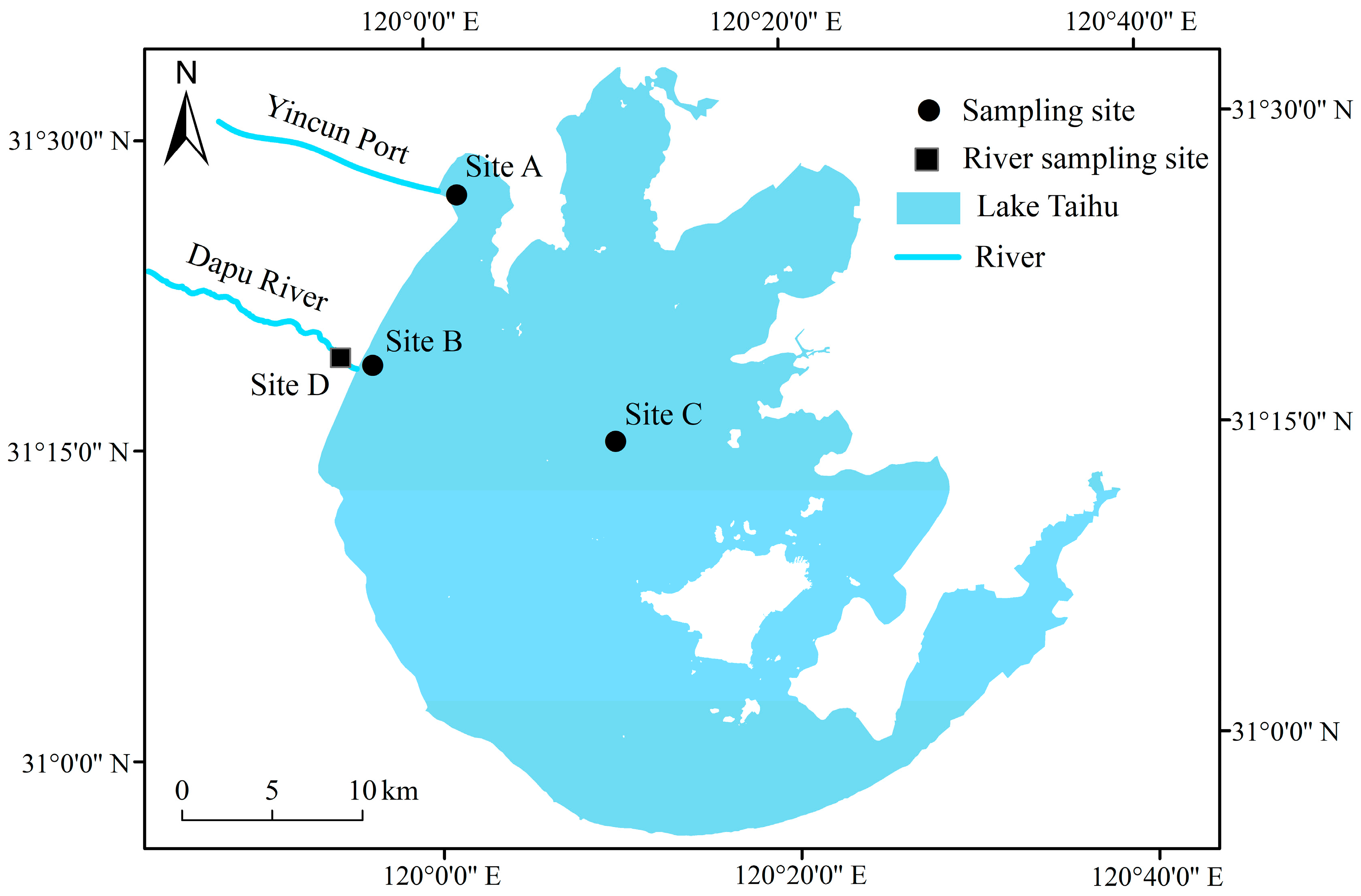
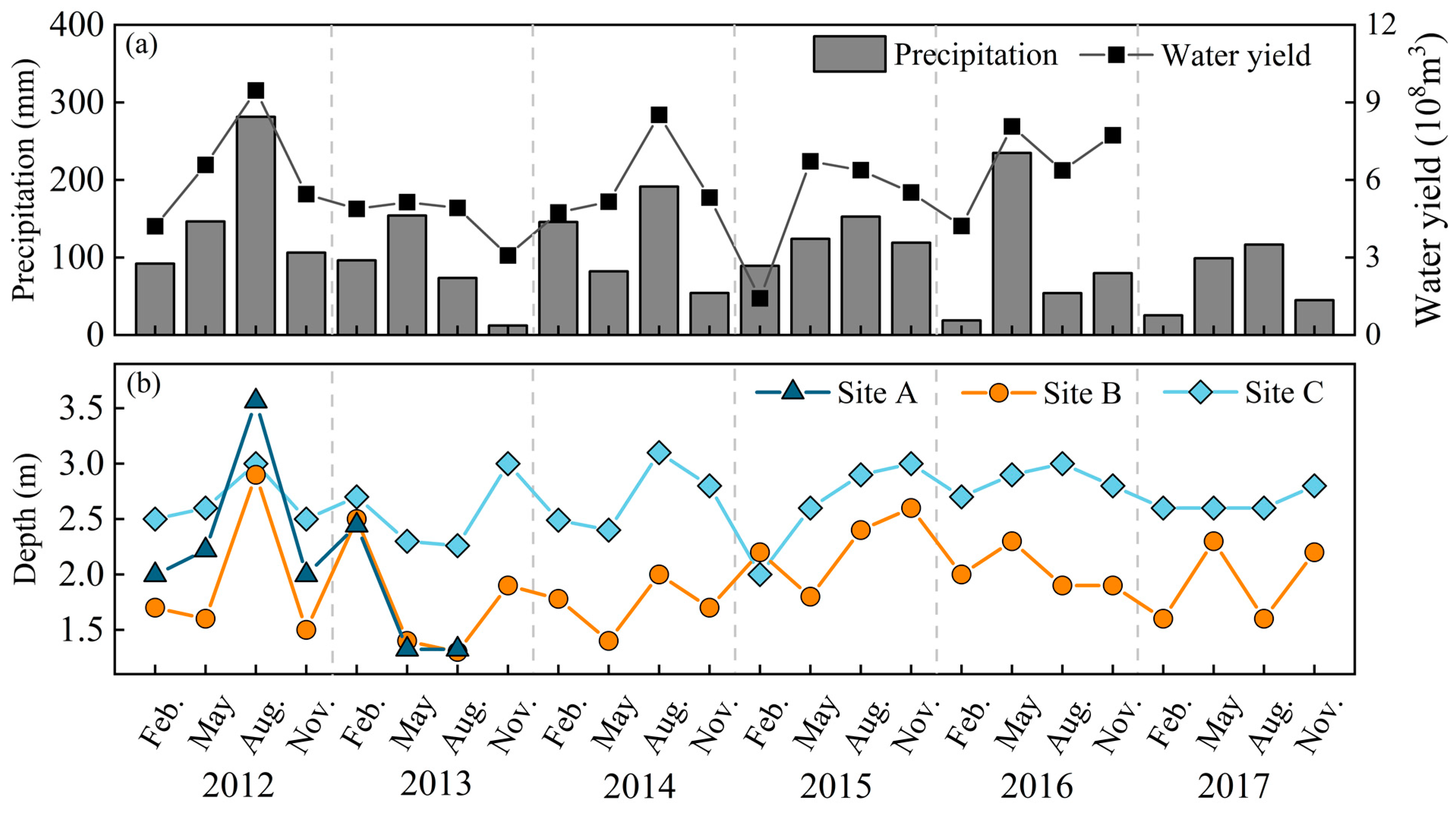
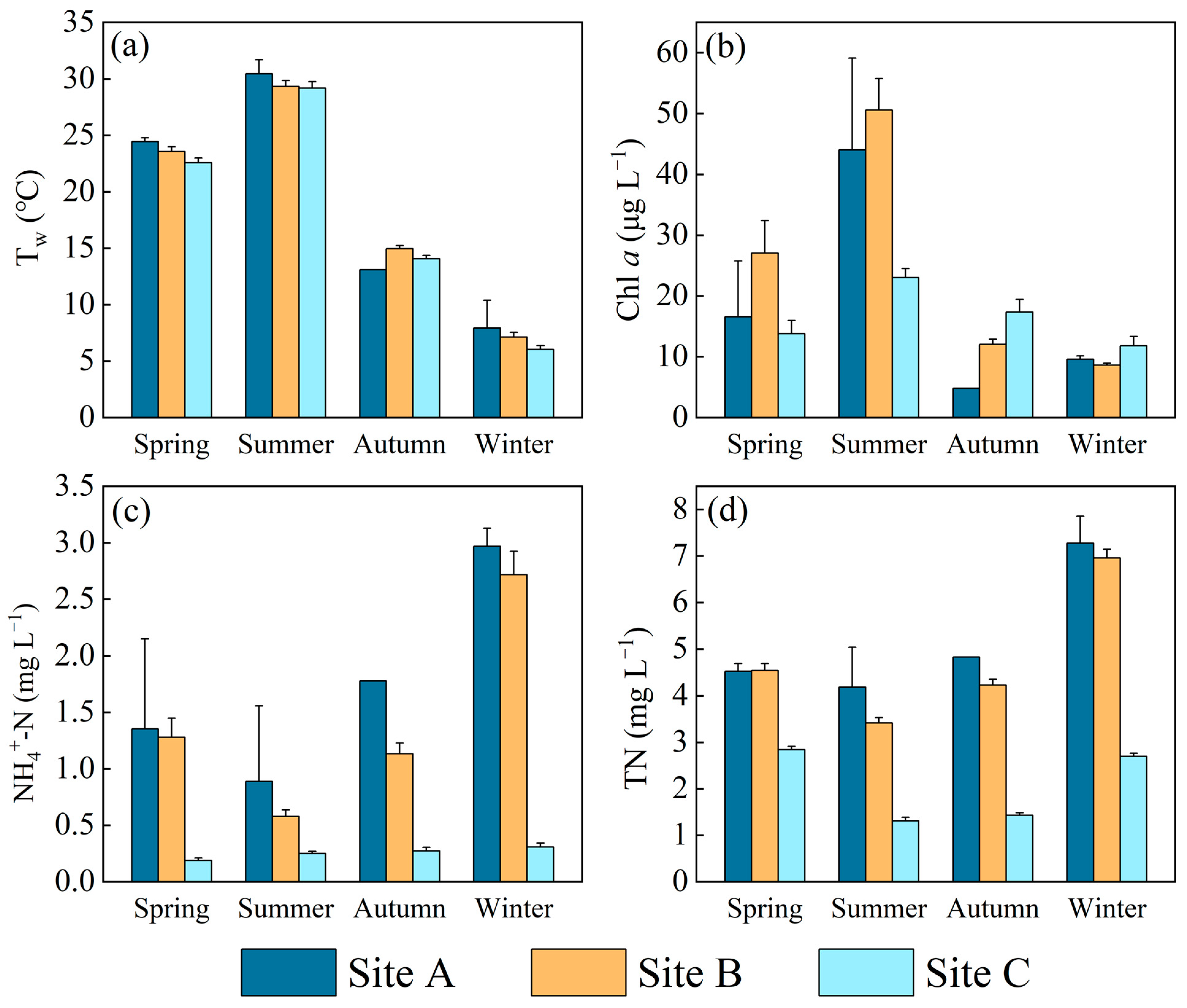
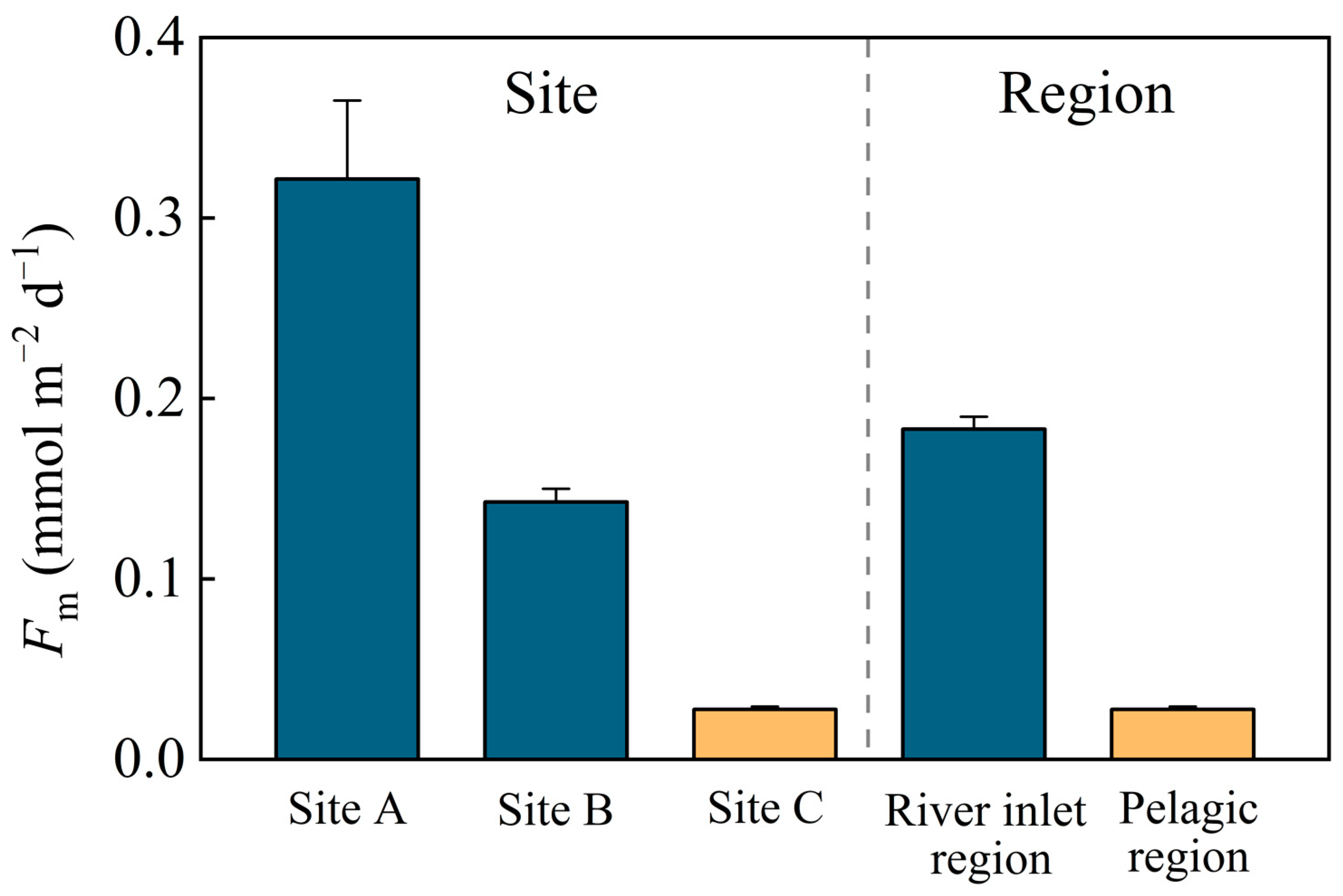
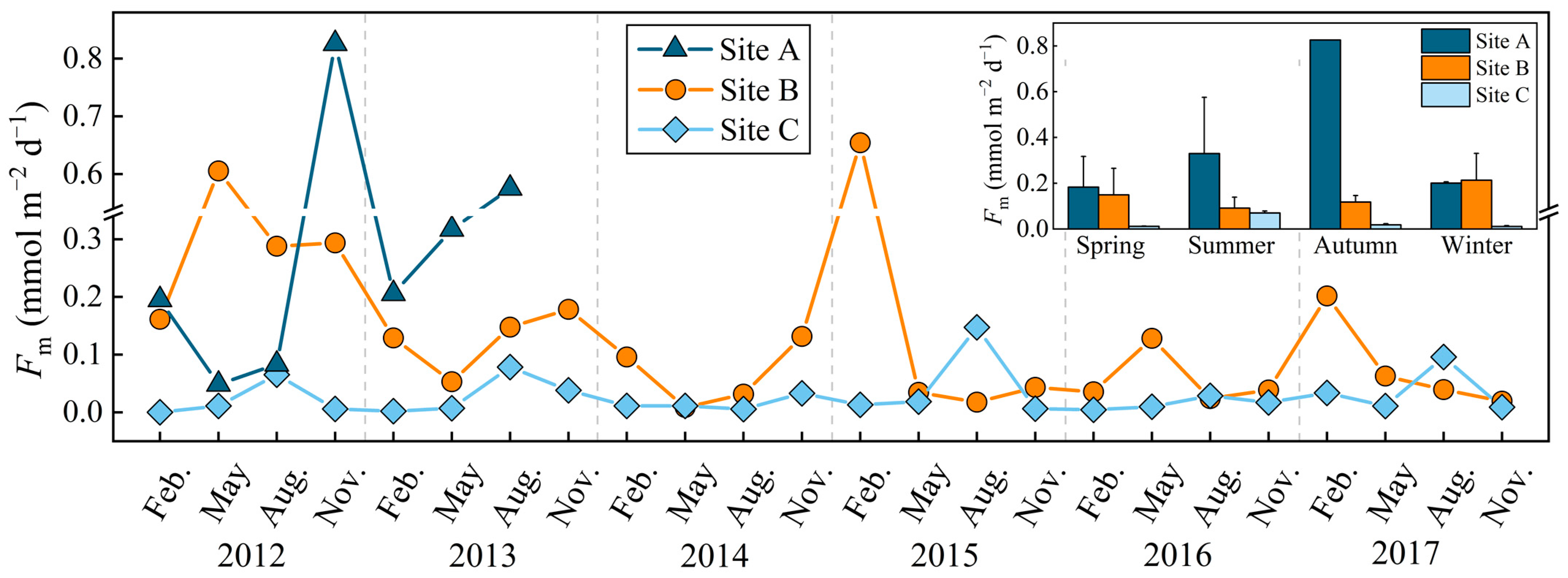
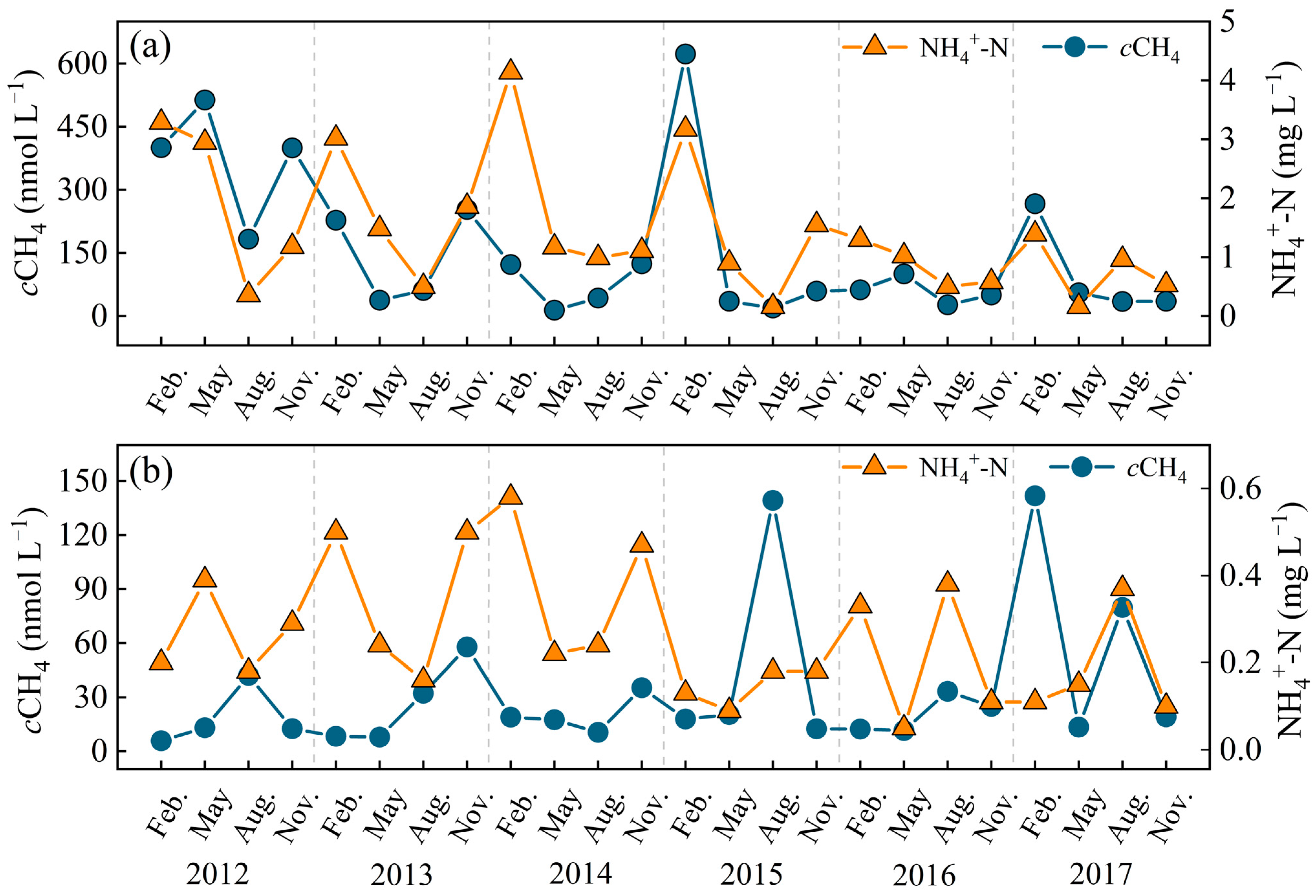
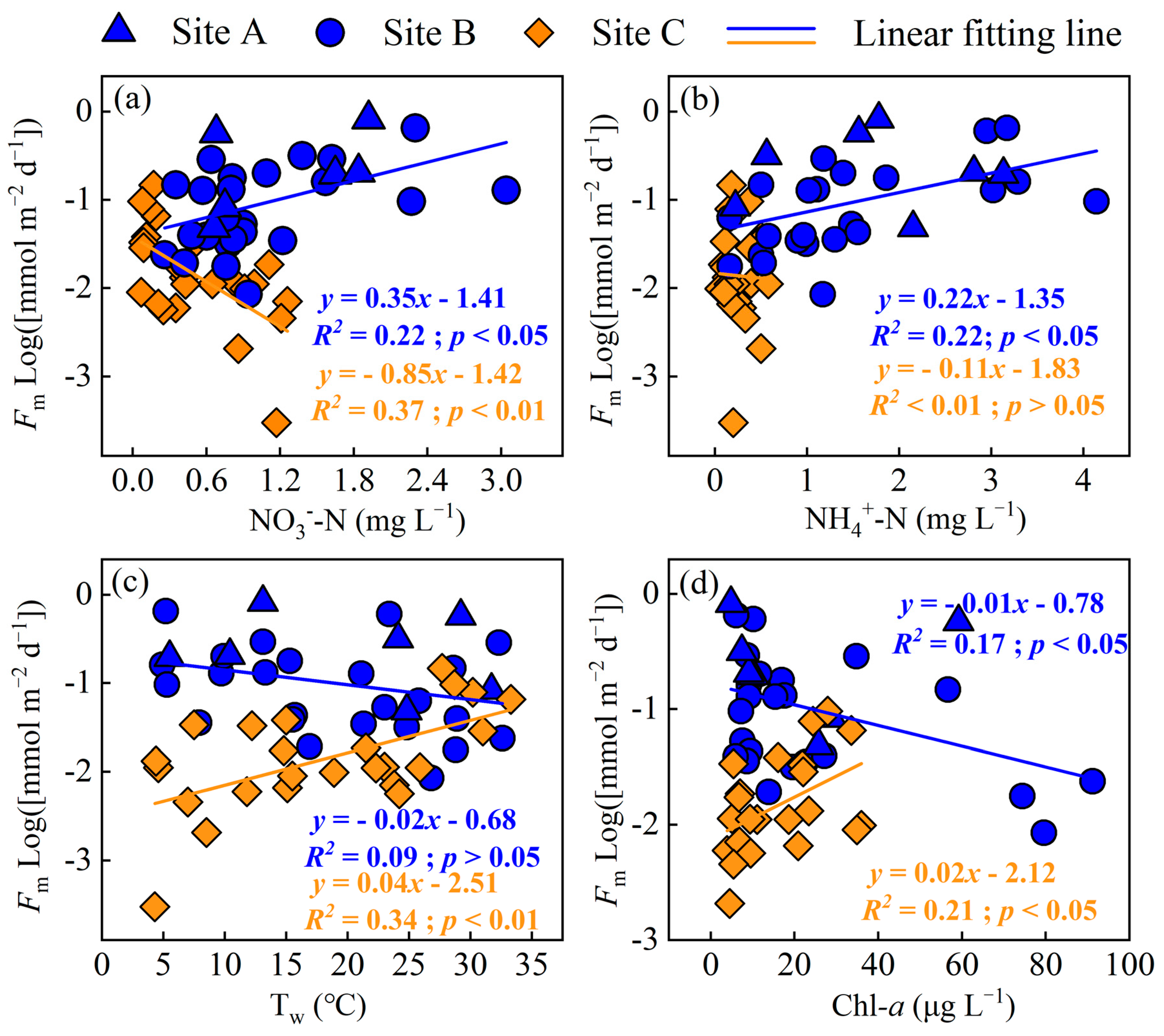

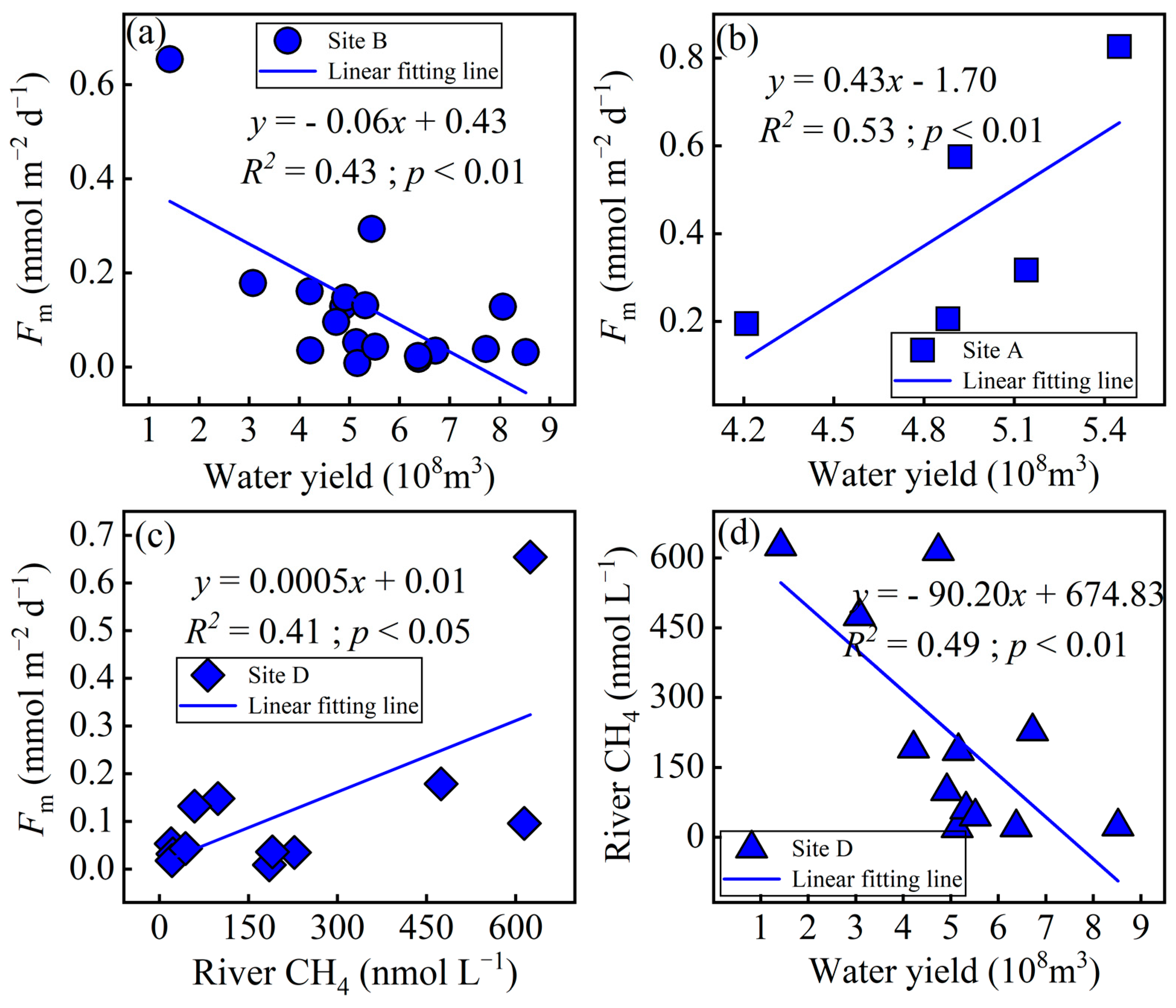
| Site | Tw (℃) | Water Clarity (m) | pH | Deph (m) | DO (mg L−1) | (mg L−1) | (mg L−1) | TN (mg L−1) | TP (mg L−1) | DOC (mg L−1) | Chl a (μg L−1) |
|---|---|---|---|---|---|---|---|---|---|---|---|
| Site A | 19.83 ± 9.34 | 0.35 ± 0.10 | 8.04 ± 0.16 | 1.96 ± 0.32 | 6.09 ± 1.22 | 1.27 ± 0.52 | 1.74 ± 1.00 | 5.26 ± 1.41 | 0.26 ± 0.06 | 5.50 ± 0.66 | 20.76 ± 17.91 |
| Site B | 18.75 ± 8.69 | 0.26 ± 0.09 | 7.98 ± 0.23 | 1.94 ± 0.41 | 6.16 ± 1.67 | 1.03 ± 0.66 | 1.43 ± 1.07 | 4.79 ± 1.50 | 0.30±0.16 | 4.96 ± 0.97 | 24.48 ± 24.92 |
| Site C | 17.97 ± 8.97 | 0.31 ± 0.12 | 8.24 ± 0.27 | 2.67 ± 0.27 | 8.98 ± 1.74 | 0.52 ± 0.41 | 0.26 ± 0.15 | 2.07 ± 0.78 | 0.09 ± 0.03 | 3.70 ± 0.86 | 16.52 ± 10.12 |
Disclaimer/Publisher’s Note: The statements, opinions and data contained in all publications are solely those of the individual author(s) and contributor(s) and not of MDPI and/or the editor(s). MDPI and/or the editor(s) disclaim responsibility for any injury to people or property resulting from any ideas, methods, instructions or products referred to in the content. |
© 2022 by the authors. Licensee MDPI, Basel, Switzerland. This article is an open access article distributed under the terms and conditions of the Creative Commons Attribution (CC BY) license (https://creativecommons.org/licenses/by/4.0/).
Share and Cite
Liao, Y.; Lan, H.; Zhang, X.; Liu, Z.; Zhang, M.; Hu, Z.; Duan, H.; Xiao, Q. Large Methane Emission from the River Inlet Region of Eutrophic Lake: A Case Study of Lake Taihu. Atmosphere 2023, 14, 16. https://doi.org/10.3390/atmos14010016
Liao Y, Lan H, Zhang X, Liu Z, Zhang M, Hu Z, Duan H, Xiao Q. Large Methane Emission from the River Inlet Region of Eutrophic Lake: A Case Study of Lake Taihu. Atmosphere. 2023; 14(1):16. https://doi.org/10.3390/atmos14010016
Chicago/Turabian StyleLiao, Yuanshan, Haijin Lan, Xinyue Zhang, Zhenjing Liu, Mi Zhang, Zhenghua Hu, Hongtao Duan, and Qitao Xiao. 2023. "Large Methane Emission from the River Inlet Region of Eutrophic Lake: A Case Study of Lake Taihu" Atmosphere 14, no. 1: 16. https://doi.org/10.3390/atmos14010016





